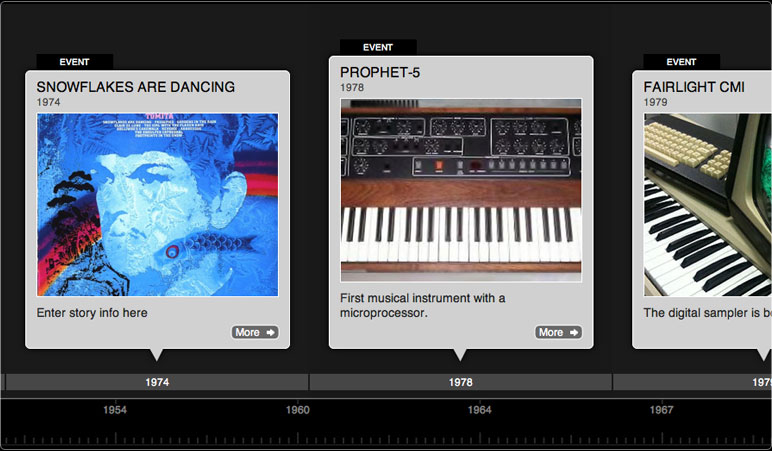Timeline of the month: History of Electronic Music
8th Mar 2013 | Tasha G
We've got another fascinating featured timeline this month: Matthew Davidson's timeline of Electronic Music. Matthew very kindly took the time to write out some great points about his timeline, so we're going to do a Q&A format to better share this with you!
Q: What's the background of this timeline? Why this topic?
A: My Electronic Music timeline is a work in progress, and by no means complete. I teach at Berklee College of Music and I needed a way to give my students a sense of why things are the way they are. I can play an example of an important milestone of electronic music, but a timeline helps me put it into context. Electronic music is shaped profoundly by the available technology and I used the timeline to show technological advances along with the history of the music itself. The pioneers of electronic music had to make use of primitive and unwieldy technology that was developed for other applications. In all cases, history remembers those that overcame the technical obstacles though the application of intensive labor.
Q: What’s the most interesting thing you learned making it?
A: The most interesting thing I learned is how incredibly difficult it is to pin down the time of a technological development. For example, the transistor. You should be able to point to a single moment and say "AHA! Here is the birth of the transistor". But it isn't that simple. In 1925, physicist Julius Lilienfeld filed a patent for the field-effect transistor (FET) in Canada in 1925. But no prototype. In 1947, John Bardeen and Walter Brattain at Bell Labs observed that when two gold point contacts were applied to a crystal of germanium, a signal was produced with the output power greater than the input. Bardeen, Brattain and Shockley invented what was the first bipolar point-contact transistor in 1947. In 1948, the point-contact transistor was independently invented by German physicists Herbert Mataré and Heinrich Welker. Finally, the first silicon transistor was produced by Texas Instruments in 1954. So, the actual birth of the transistor spans over 25 years.
Q: What are you hoping to get out of your timeline?
A: My goal is to get my students to think beyond what is possible with today's technology. There are many examples in the timeline (Charles Babbage, Phonautograph) where the results were not obtained for 150 years because the technology of the time was too primitive. This is the very definition of being ahead of your time.
Many thanks to Matthew for his insightful responses to our questions! As ever, if you have or know of a timeline you think is worth featuring, get in touch with us at blog@tiki-toki.com.
Thanks for reading, and enjoy exploring the timeline!
